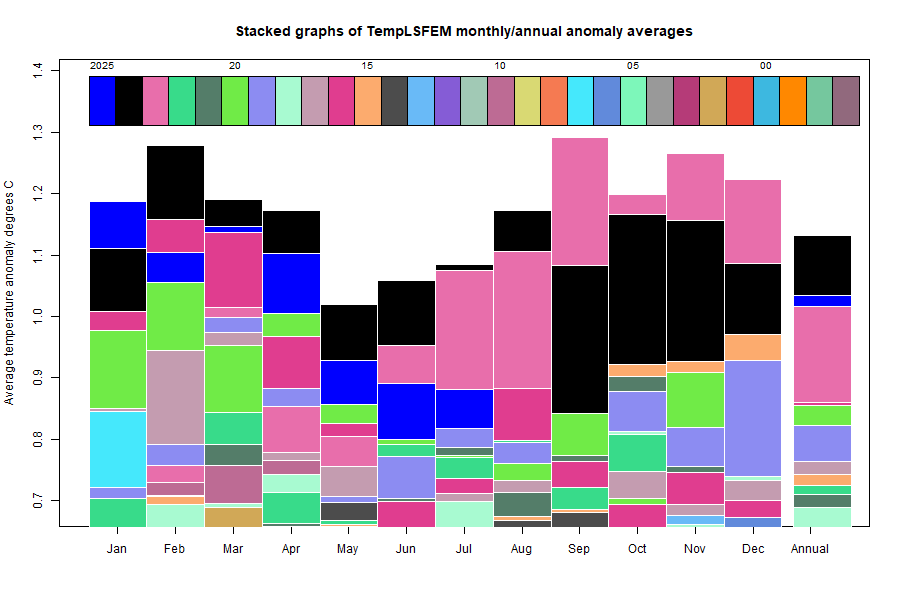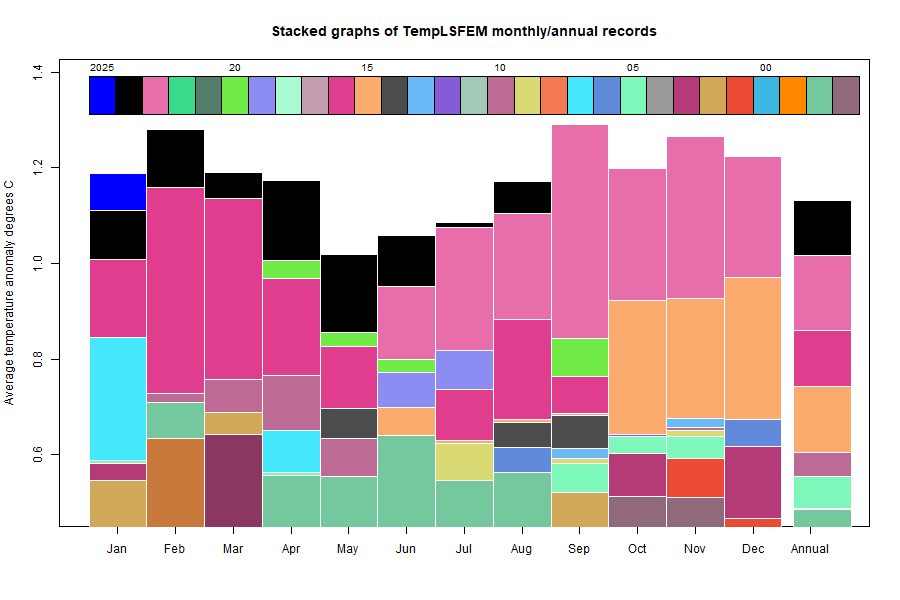The GISS V4 land/ocean temperature anomaly was 1.37°C in December, down from 1.43°C in November. This fall is very similar to the 0.064°C fall reported for TempLS.
As with TempLS, December was still by a large margin the warmest December in the record - next was 1.16°C in 2015.
As usual here, I will compare the GISS and earlier TempLS plots below the jump.
Sunday, January 14, 2024
Tuesday, January 9, 2024
Graphics to show magnitude of 2023 warming.
My previous post, with the December anomaly average, completed the years results and confirmed what has been obvious for a while, that 2023 is the hottest year that has been measured. It was 0.158°C warmer than 2016, the next warmest year, which itself stood above previous years.
I'd like here to collect some graphics which will put this into proportion. It comes from a collection (for various indices) that I am updating and posting on the data page. The first is oneof a kind that I show whenever there is a record year. It is just a bar chart of the temperatures, but colored in a way that shows the progress of the record values:

The second is one that I have been showing for a while. It is a stacked graph of monthly and annual temperatures. It is like a bar chart, but the months have been gathered in one slot, and arranged in order of size, tallest at the back. Annual is shown as well. Since June, 2023 towers over the rest:

And here is a graph with a different ordering, by time, newest at the back. Each rectangle you now see was a record in its time, so gives an idea of how record setting 2023 was. 2016 was not so far behind, but based on just four very warm months. However, there is a calendar effect here. The 2015/6 peak was split between two years; taken together, they were actually larger than 2023, as you see from the annual column. Still, the current one isn't finished by any means.

I'd like here to collect some graphics which will put this into proportion. It comes from a collection (for various indices) that I am updating and posting on the data page. The first is oneof a kind that I show whenever there is a record year. It is just a bar chart of the temperatures, but colored in a way that shows the progress of the record values:

The second is one that I have been showing for a while. It is a stacked graph of monthly and annual temperatures. It is like a bar chart, but the months have been gathered in one slot, and arranged in order of size, tallest at the back. Annual is shown as well. Since June, 2023 towers over the rest:

And here is a graph with a different ordering, by time, newest at the back. Each rectangle you now see was a record in its time, so gives an idea of how record setting 2023 was. 2016 was not so far behind, but based on just four very warm months. However, there is a calendar effect here. The 2015/6 peak was split between two years; taken together, they were actually larger than 2023, as you see from the annual column. Still, the current one isn't finished by any means.

Monday, January 8, 2024
December global surface TempLS down 0.064°C from November, but still warmest December in record.
The TempLS FEM anomaly (1961-90 base) was 1.214°C in December, down from 1.278°C in November. It was still by far the warmest December in the record by 0.229°C, ahead of 0985°C in 2015. The NCEP/NCAR reanalysis base index rose by 0.031°C.
It confirms 2023 as the hottest year in the record; I'll write more about that with graphics in a coming post. I have added a gallery of graphics to the data page here. For now, I'll just show the stacked graph of monthly temperatures, to show how the last seven months stand out:
Here is the corresponding stacked graph, showing how much hotter recent months have been, as well as the now completed year of 2023:

North America was very warm. Scandinavia was cold, as was a section of East Siberia. Antarctica was cold.
Here is the temperature map, using the FEM-based map of anomalies. Use the arrows to see different 2D projections.
As always, the 3D globe map gives better detail. There are more graphs and a station map in the ongoing report which is updated daily.
It confirms 2023 as the hottest year in the record; I'll write more about that with graphics in a coming post. I have added a gallery of graphics to the data page here. For now, I'll just show the stacked graph of monthly temperatures, to show how the last seven months stand out:
Here is the corresponding stacked graph, showing how much hotter recent months have been, as well as the now completed year of 2023:

North America was very warm. Scandinavia was cold, as was a section of East Siberia. Antarctica was cold.
Here is the temperature map, using the FEM-based map of anomalies. Use the arrows to see different 2D projections.
As always, the 3D globe map gives better detail. There are more graphs and a station map in the ongoing report which is updated daily.